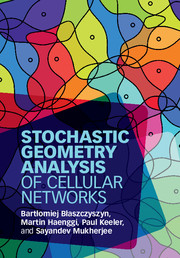Book contents
- Frontmatter
- Contents
- Preface
- Acknowledgments
- Notations
- List of Acronyms and Abbreviations
- Part I Stochastic Geometry
- Part II SINR Analysis
- Concluding Remarks
- Appendix A Proof of Lemma 5.3.6
- Appendix B Timeline of Cellular Technology Generations
- Appendix C Some Useful Probability Distributions
- References
- Index
Preface
Published online by Cambridge University Press: 26 March 2018
- Frontmatter
- Contents
- Preface
- Acknowledgments
- Notations
- List of Acronyms and Abbreviations
- Part I Stochastic Geometry
- Part II SINR Analysis
- Concluding Remarks
- Appendix A Proof of Lemma 5.3.6
- Appendix B Timeline of Cellular Technology Generations
- Appendix C Some Useful Probability Distributions
- References
- Index
Summary
Since 2010, our knowledge of coverage and capacity in heterogeneous cellular networks (HetNets) has expanded rapidly, primarily through analytical results using stochastic geometry. Most of these results assume that the locations of the base stations in a given tier of the HetNet are the points of a homogeneous Poisson point process (PPP). This modeling assumption was made for mathematical tractability, and the coverage results for a single tier were determined to be about as pessimistic (relative to the real coverage in real-world deployments) as the regular hexagonal lattice location model was optimistic (Andrews, Baccelli, & Ganti 2011).
However, since 2013 we have obtained results showing the fundamental importance of the PPP model to the analysis of real-world deployments in two ways: (a) the set of propagation losses to the typical location in an arbitrary network deployment converge asymptotically to that from a PPP deployment of base stations; (b) long before this convergence is reached, the coverage results for a PPP deployment can be employed to obtain very accurate approximations to the coverage results for various regular deployments.
This book provides the first detailed expository treatment of these results, and includes additional exact analytical results on coverage for certain special non-PPP deployment models.We expect the book to be of interest to researchers in academia and industry, and anyone interested in the application of stochastic geometry to problems in communication. HetNets are an important component of future cellular network standards (LTE Release 12 and later), and the theoretical results in the book are illustrated with examples of their application to transmission scenarios specified in the LTE standard.
Although we have made every effort to make the book self-contained, the reader will benefit from having had some prior exposure both to the theory and techniques of stochastic geometry, and to their application to the derivation of coverage results for PPP base station deployments. For an introduction to stochastic geometry with emphasis on wireless communications, we recommend Haenggi's Stochastic Geometry for Wireless Networks (Haenggi 2012) at the introductory level (a condensed version of which is available in Chapter 3) and the two volumes of Baccelli and Błaszczyszyn's Stochastic Geometry and Wireless Networks (Baccelli & Błaszczyszyn 2009a, 2009b) for a comprehensive treatment at the advanced level.
- Type
- Chapter
- Information
- Stochastic Geometry Analysis of Cellular Networks , pp. ix - xPublisher: Cambridge University PressPrint publication year: 2018

